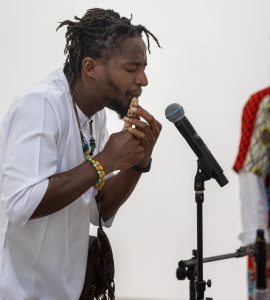Uzor Maxim Uzoatu
The world is in rapture over Nigerian art and music.
Anywhere you go in the major capitals across the globe, all the rage is Nigeria’s compelling art and music.
Let’s take a trip to the standout exhibition “Njideka Akunyili Crosby: Coming Back to See Through, Again” that held between September 14 and October 28, 2023 at 519 West 19th Street, New York, USA.
The exhibition also featured “Igbo Rising – A Performance of Nigerian Traditional Music” by Gerald Eze.
Njideka Akunyili Crosby is the daughter of Nigeria’s arguably most-celebrated public servant of blessed memory, Prof Dora Akunyili, and Dr. Cyril Akunyili who was gruesomely murdered by the so-called unknown gunmen.
Born in Enugu in 1983, and a native of Agulu, the town by the famous lake, in Anambra State, Njideka Akunyili left Nigeria for the United States in 1999, and now works her art out of Los Angeles, California.

It was at the wedding in Enugu of Njideka Akunyili Crosby’s brother Obumneme Akunyili that she met Gerald Eze, the master of the Igbo traditional musical instrument Oja for which I fondly address him as “Ogbu-Oja Global.”
Njideka and Gerald got into conversation about Igbo culture and the contemporary interpretation of Igbo art and music.
Gerald told her of how early in life he once left for the Catholic Altar Boys’ practice in Amawbia, where he grew up, only to end up at a traditional festival hosted by an Igbo shaman and masked spirits.
He was flogged when he got back home after his wandering efforts!
Njideka told the story of how early in her life she too once left the house in the village at Agulu, without letting anyone know, and walked through the village until she found herself at the precincts of the shrine of Haba Agulu.
It is little wonder then that the spirit-chasing children would eventually juxtapose art and music at the global metropole of New York.
In the words of Gerald Eze, “Our story cannot start from New York or London – it starts from home.”
The gifted artists of Igbo extraction discovered through their conversation that they are similar in the interpretation of art and music.
While Gerald reimagines traditional Igbo music and musical instruments, Njideka’s art is deeply embedded in her cultural background.
It’s as though once you see Njideka’s art pieces, you are instantly coming back to see through your memories of contemporary Nigeria, all over again.
One can then understand the title of the exhibition: “Coming Back to See Through, Again.”
The exhibition and the invitation sent to the Awka-based Gerald Eze and Ichoku Academy are best captured by one of the titles of Njideka’s exhibited works: “Ejuna na-aga, ọ kpụlụ nkọlikọ ya (while the snail moves, it takes along its shells).”
David Zwirner is the driving force of the Njideka Akunyili Crosby exhibition.
After the debut in Los Angeles in May 2023, Njideka’s first solo exhibition in New York took place from September 14 to October 28.
Njideka Akunyili Crosby “combines painted depictions of people, places, and subjects from her life with photographic transfers derived from her personal image archive as well as Nigerian magazines and other mass media sources. The resulting works are visual tapestries that vivify the personal and social dimensions of contemporary life while evocatively expressing the intricacies of African diasporic identity.”
Highlights of the exhibition include the showcasing of Njideka’s two new works from her series entitled “The Beautyful Ones”, inspired by the 1968 classic novel The Beautyful Ones Are Not Yet Born by the iconoclastic Ghanaian novelist Ayi Kwei Armah.
With Njideka’s paintings in view, one can reimagine Armah’s creations such as Chichidodo, the bird that hates excrement but only feeds on maggots which grow in the lavatory, and Aboliga the Frog’s picture of the man-child that impossibly completes the cycle from babyhood to adulthood and decaying death in seven short years!
In the music vein, Gerald Eze opened the event with a chant, accompanied by harp-like melodies on his Uboaka, a traditional Igbo lamellophone.
Through the chant, he invited the audience into the spiritual experience of Igbo classical music: Kilibe Nu Nka, Omenka Njideka n’eti uwa mmonwu – (take a view of arts, the Artist Njideka is exhibiting the manifestation of spirits).
With the song “Udenguma,” Gerald told the story of an artist who dared all odds, including death, to dance for the community, thus bringing the audience into a transcendental experience of Njideka’s art through his music.
The song Ifediche “The Difference” was dedicated to Njideka as a unique artist, while Gerald’s recent composition, “Mmirioma,” honoured the Igbo spirit of resilience which was demonstrated by the Igbo people who resisted slavery and rather drowned at Dunbar Creek, St. Simons Island.
This story of resilience was called “Igbo Landing,” but the concert was tagged “Igbo Rising: A Performance of Nigerian Music.”
Gerald began this powerful song with the Oja which is an instrument that inspires bravery and resilience in the Igbo.
He concluded with the performance of “Rise and Shine,” inviting the audience to rise to the tides of a new dawn.
Gerald donated Uboaka produced in Ichoku Academy, and an Oja, to the team of staff and students from Wide Rainbow School, New York, and taught them Igbo music as part of the exhibition programme.
With this latest move, Igbo musical instruments and folk songs are gradually becoming relevant in art and educational institutions in the United States, as they now contribute to diversity, education and entertainment.
Gerald Eze performed alongside Sandra Chisom Umeh, his former music student at Nnamdi Azikiwe University in Awka, and Will Calhoun who is an African-American Grammy award-winning drummer.
With the international support of David Zwirner, his art gallery team of Anthony Gelfand, Felice Jiang, Courtney Snyder, and Andre Keichian who is Njideka’s studio manager, Njideka Akunyili Crosby and Gerald Eze are taking African art and music from the village square to the universe.
It’s a modern-day rising worthy of intercontinental celebration.